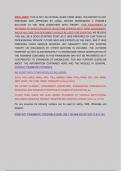Samenvatting
STUDY GUIDE MACROECONOMICS ERASMUS UNIVERSITY COLLEGE 2020, European perspective Blanchard, Amighini and Giavazzi, Samenvatting, summary
This document is specifically made for students at EUC following the course macro-economics! It's a concise guide that also includes all the lecture notes you need. Good luck with your exam! Chapter 2, 3, 4 (incl. appendix), 5, 6 (6.1, 6.2, 6.4) 7, 8, 9,10, 11, 12, 17, 18, 19 and 20.1. From the bo...
[Meer zien]














